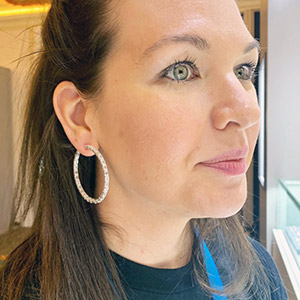
As consumers begin a return to “normal,” it’s natural to wonder how or if this past year’s shopping trends will change. Retailers are beginning to loosen restrictions, and people are, perhaps cautiously, returning to in-store shopping.
But the convenience and ease of e-commerce can’t be denied, and while it has been a core focus for many big businesses—with Amazon leading the charge—it has also become a profitable avenue for small, independently owned stores. If 2020 said anything about e-commerce, it was “Go online or go out of business,” at least for many.
Shoppers have gotten used to buying online (yes, even luxury goods!), and a transition to in-store again doesn’t mean all or nothing. That’s why it’s important to not let your guard down with your e-commerce efforts, and pay attention to how you can cater to those up-and-coming consumer segments—Gen Z, in particular.
A recent infographic from product sourcing app Oberlo explains 10 e-commerce trends that retailers should be aware of in 2021. You can read about all 10 here, but below are a handful of highlights that jewelry retailers should pay attention to immediately.
Online sales will only keep growing
According to data from eMarketer, online sales are projected to increase from $4.9 trillion in 2021 to $6.4 trillion in 2024. With websites becoming increasingly user-friendly and accommodating of online purchases, shoppers are becoming ever more comfortable and even used to conducting business this way.
Expect the trend to continue post-COVID-19
Though a major surge in e-commerce was no doubt in part to the lockdowns that came with the COVID-19 pandemic, experts agree that this form of shopping is here to stay. Think of how comfortable many people are with purchasing things online, after having experienced how easy and convenient it is. This won’t be the case for all goods, but given what we know now, and with consumers’ busy schedules at home and at work, why would anyone feel the need to go back to mostly shopping in person?
Market analysts seem to think that the e-commerce industry will be the biggest beneficiary of the pandemic—penetration rates are currently at 15%, according to MarketWatch, and are predicted to increase to 25% by 2025.
The growth of mobile shopping is notable
Think about the times you’ve made online purchases in the last year. With the endless options of apps available and your phone ever-present in your hand, how many of those transactions did you make on a computer (or even more ancient, via telephone?). In 2020, total sales via mobile devices clocked in at a whopping $2.66 trillion—and this figure is expected to grow to $3.16 trillion this year alone (according to Payvision).
With that information in mind, it’s more important than ever to ensure your website is mobile-friendly. Even if you don’t yet have e-commerce capabilities, making it easy to visit your website via smartphone or tablet will ensure potential customers can easily get the information they need.
Young consumers are driving the shift
It should come as no surprise that it’s a younger generation of shoppers—between the ages of 18 to 34—that is behind this monumental shift in how we get our goods. While consumers of all ages have been spending more time online since the pandemic, survey results from Shopify show that two out of three consumers in that age group are spending more money purchasing items online now than before the pandemic. Other segments aren’t far behind, though: Consumers ages 35 to 54 increased their online shopping by 57%, and for those 55 and above, that number was 41%.
It’s worth considering the age of all customers when thinking about how you target your ads or the types and price points of products you sell online, but, as the younger generation seems more inclined to spend online, it’s them you want to convince to do so with you.
Social media is playing a bigger role
No surprise here: Apps like TikTok, Facebook, and Instagram are picking up speed when it comes to digital sales. While people were already being influenced to purchase items worn by their favorite bloggers or celebrities, now they don’t even have to leave their apps to do so.
Not only should you consider sponsored posts—or even just more frequent posting—on your social, but if you have a Shopify account, you can link your online store through social media (after meeting a certain number of qualifications), which will allows shoppers to purchase directly through those sites.
It also helps to consider, once you’re set up, how to directly sell to consumers through social media. We’ve often sung the praises of brands and retailers that can just be who they are and envelop their followers in the experiences that define their brand—but adding a call to action to press “buy” takes it to another level. Retailers will need to play with the best approaches that work for them, but staying the course in keeping it real, while engaging customers with the products and services offered, is still a best bet.
Independent businesses are desirable
Great news for small businesses and retailers: A survey from Shopify shows that 57% of consumers express a willingness to purchase from new and independent businesses for the first time.
There are a number of reasons why this could be the case, most notably because younger shoppers are looking for different things, and feeling a desire to stand out from the crowd and not buy things everyone around them seems to be buying. There’s also a big push in responsible shopping habits—taking into account sustainability and environmental practices—that encourage shopping small.
Which gives you all the more reason to retain a personable experience with your followers online, while shedding light on any and all practices that make small businesses the right choice for their needs.
Augmented reality is on the rise
You’ve just gotten your e-commerce website under control when you start hearing about augmented reality (AR)—it can feel overwhelming! But there are some great perks to using AR for your products, because it will help consumers to envision wearing or using them without ever having to leave home.
Perhaps you’ve seen it before: A furniture website lets you picture what one of its offerings would look like in your space. A makeup store lets you virtually try on a certain shade of lipstick. Even some jewelers are giving shoppers the capability to don a pair of earrings from their phones (you can see our Victoria Gomelsky “trying on” a pair of Emily P. Wheeler earrings via Instagram in this JCK article from January).
By all means, squarely nail your e-commerce capabilities first. But know that AR is quickly becoming one of the most talked-about and near-necessary features available to virtual consumers today, and, when you’re ready, you should absolutely outfit your website with the capability to use it.
See the infographic in its entirety and get more information on Oberlo’s blog.
(Photo: Getty Images)
Follow JCK on Instagram: @jckmagazineFollow JCK on Twitter: @jckmagazine
Follow JCK on Facebook: @jckmagazine






